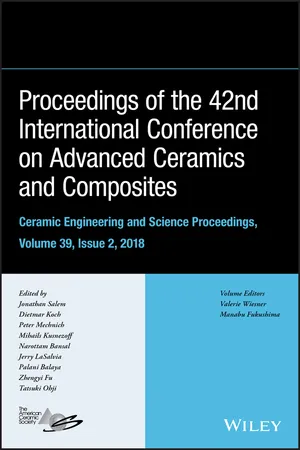
Proceedings of the 42nd International Conference on Advanced Ceramics and Composites, Volume 39, Issue 2
- English
- ePUB (mobile friendly)
- Available on iOS & Android
Proceedings of the 42nd International Conference on Advanced Ceramics and Composites, Volume 39, Issue 2
About this book
Proceeding of the 42nd International Conference on Advanced Ceramics and Composites, Ceramic Engineering and Science Proceedings Volume 39, Issue 2, 2018
Jonathan Salem, Dietmar Koch, Peter Mechnich, Mihails Kusnezoff, Narottam Bansal, Jerry LaSalvia, Palani Balaya, Zhengyi Fu, and Tatsuki Ohji, Editors
Valerie Wiesner and Manabu Fukushima, Volume Editors
This proceedings contains a collection of 25 papers from The American Ceramic Society's 41st International Conference on Advanced Ceramics and Composites, held in Daytona Beach, Florida, January 21-26, 2018. This issue includes papers presented in the following symposia:
• Symposium 1: Mechanical Behavior and Performance of Ceramics and Composites
• Symposium 2: Advanced Ceramic Coatings for Structural, Environmental, and Functional Applications
• Symposium 3: 15th International Symposium on Solid Oxide Fuel Cells (SOFC)
• Symposium 4: Armor Ceramics: Challenges and New Developments
• Symposium 6: Advanced Materials and Technologies for Direct Thermal Energy Conversion and Rechargeable Energy Storage
• Symposium 8: 12th International Symposium on Advanced Processing & Manufacturing
Frequently asked questions
- Essential is ideal for learners and professionals who enjoy exploring a wide range of subjects. Access the Essential Library with 800,000+ trusted titles and best-sellers across business, personal growth, and the humanities. Includes unlimited reading time and Standard Read Aloud voice.
- Complete: Perfect for advanced learners and researchers needing full, unrestricted access. Unlock 1.4M+ books across hundreds of subjects, including academic and specialized titles. The Complete Plan also includes advanced features like Premium Read Aloud and Research Assistant.
Please note we cannot support devices running on iOS 13 and Android 7 or earlier. Learn more about using the app.
Information
15TH INTERNATIONAL SYMPOSIUM ON SOLID OXIDE FUEL CELLS (SOFC): MATERIALS, SCIENCE, AND TECHNOLOGY
INVESTIGATION OF (La1-X,CaX)(Ni0.25Fe0.25Cr0.25Co0.25)O3 FOR SOLID OXIDE FUEL CELLS CATHODE MATERIALS
ABSTRACT
INTRODUCTION
Table of contents
- COVER
- TITLEPAGE
- COPYRIGHT
- INTRODUCTION
- MECHANICAL BEHAVIOR AND PERFORMANCE OF CERAMICS AND COMPOSITES
- ADVANCED CERAMIC COATINGS FOR STRUCTURAL, ENVIRONMENTAL, AND FUNCTIONAL APPLICATIONS
- 15TH INTERNATIONAL SYMPOSIUM ON SOLID OXIDE FUEL CELLS (SOFC): MATERIALS, SCIENCE, AND TECHNOLOGY
- Armor Ceramics: Challenges and New Developments
- Advanced Materials and Technologies for Direct Thermal Energy Conversion and Rechargeable Energy Storage
- 12th International Symposium on Advanced Processing & Manufacturing Technologies for Structural & Multifunctional Materials and Systems
- Eula